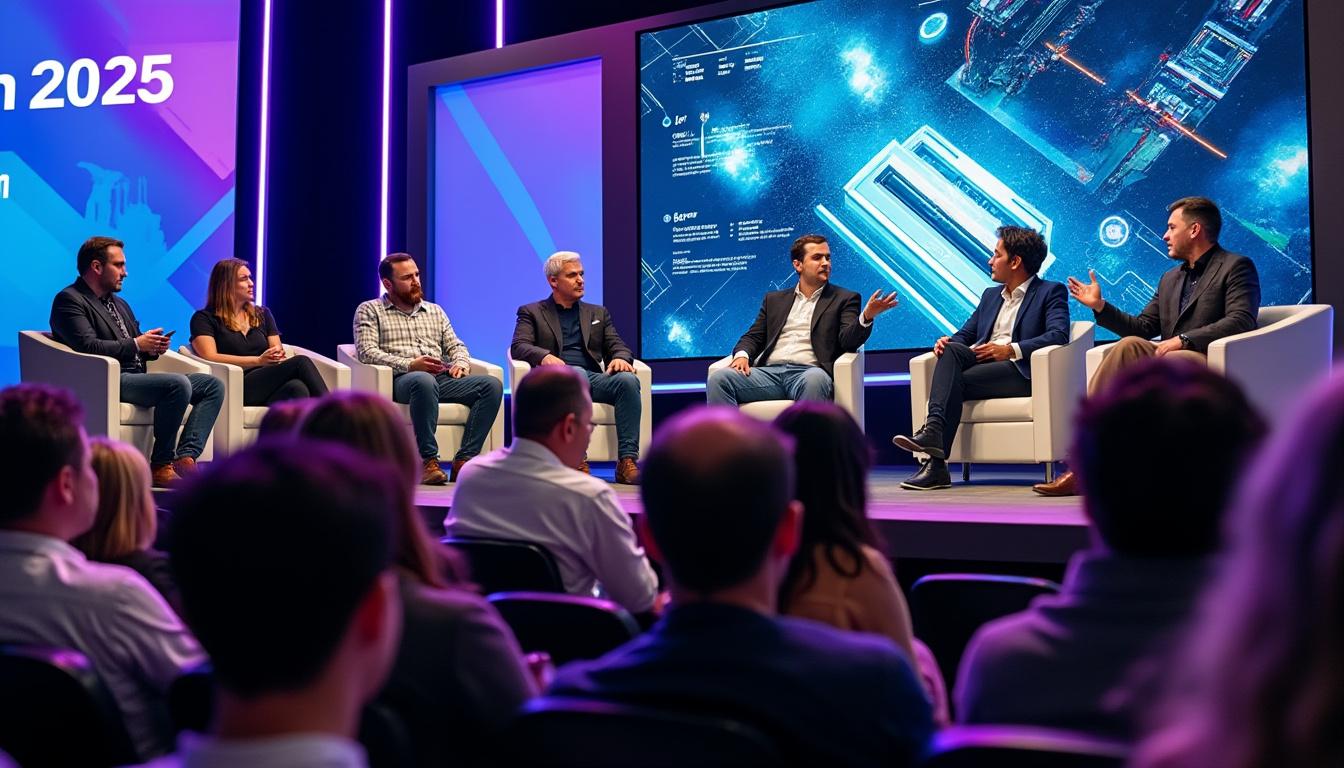Gaming in the Age of Empowered AI: Devcom 2025 Panel Overview
The phrase Gaming in the Age of Empowered AI captures the core of a technical conversation that unfolded at Devcom 2025. The panel concentrated on practical integrations, governance considerations, and commercial realities driving the next wave of games. Attendees included engineering leads and product strategists representing engines, platforms, and cloud providers, and the discussion emphasized measurable developer workflows rather than abstract futurism.
Highlights from the session emphasized the convergence of compute, data, and tooling: major middleware providers such as Unity and Epic Games were referenced for their runtime and content pipelines, while hardware and GPU acceleration from NVIDIA was cited for enabling on-device inference. Cloud providers like Amazon Web Services and Google Cloud AI offered the scalable backends required to host agentic systems, and OpenAI’s research was mentioned as a practical example of model-driven content creation. Microsoft Xbox and Sony PlayStation perspectives framed console constraints and certification pathways, and publishers including Ubisoft and Electronic Arts contributed commercial use cases.
Concrete examples were discussed, such as a mid-sized studio, Axiom Interactive, deploying an AI-driven NPC behavior pipeline that reduced test iteration cycles by 40%. The panel described how Unity’s editor scripting can hook into model endpoints, while Epic Games’ runtime tools enable more dynamic animation retargeting when combined with NVIDIA-accelerated inference. The case study illustrated how the enterprise stack (AWS-hosted models, Google Cloud AI for analytics) coalesced into a hybrid architecture that remained performant on consoles and PCs.
To make the session actionable, panelists outlined prioritized checkpoints for studios adopting these approaches:
- Define deterministic fallback behaviors for AI-driven systems to ensure QA stability.
- Benchmark model latency on target hardware (PC, console, cloud) using vendor tools from NVIDIA and platform telemetry from Microsoft Xbox and Sony PlayStation.
- Plan scalable storage and model management using Amazon Web Services or Google Cloud AI solutions.
- Integrate content moderation and IP provenance tracking for assets generated with OpenAI-style models.
- Create telemetry hooks to monitor player-facing agent behaviors and tune via iteration pipelines in Unity or Epic Games.
The technical balance between on-device inference and cloud-hosted intelligence was a recurring subtopic. Panelists argued for hybrid strategies where sensitive decision loops run locally under deterministic constraints, while large context updates and personalization run via cloud endpoints. This hybrid design leverages edge acceleration from NVIDIA GPUs and cloud elasticity from Amazon Web Services and Google Cloud AI, enabling both responsiveness and scale.
Operational checklist from the Devcom panel
Operationalizing Gaming in the Age of Empowered AI requires clear roles, metrics, and tooling. The panel proposed a checklist that mapped to development sprints, QA, and live-ops:
- Sprint-level objectives for AI model inclusion and regression tests.
- QA scenarios covering adversarial inputs and deterministic fallback paths.
- Live telemetry with thresholds tied to business KPIs (retention, ARPDAU, churn).
| Area | Recommended Tooling | Expected Impact |
|---|---|---|
| Content generation | OpenAI endpoints / Unity pipeline | Faster prototyping, 30-50% asset time reduction |
| Physics & animation | Epic Games runtime / NVIDIA acceleration | Smoother transitions, reduced manual keyframes |
| Scaling & analytics | Amazon Web Services / Google Cloud AI | Predictable scaling for live features |
The Devcom 2025 panel was pragmatic: emphasis leaned toward integrations that produce reliable developer outcomes today, setting the stage for larger shifts tomorrow. Gaming in the Age of Empowered AI was positioned as an operational discipline as much as a technological wave. The key insight: plan hybrid architectures with clear QA and telemetry priorities to convert experimental features into repeatable, ship-ready systems.
Gaming in the Age of Empowered AI: Technical Architectures and Hybrid Deployment
Adopting Gaming in the Age of Empowered AI demands clarity around architectures that mix local deterministic systems with cloud-hosted learning. Panelists at Devcom 2025 mapped several viable patterns: edge-first inference, cloud-augmented personalization, and federated telemetry for privacy-aware tuning. Each pattern carries trade-offs in latency, cost, and maintainability.
Edge-first inference places decision loops on end-user devices. This approach reduces latency and gives predictable performance profiles for gameplay-critical systems, but it requires careful model quantization and hardware-aware optimizations. Tools from NVIDIA accelerate on-device inference, while console-specific SDKs ensure compliance with Microsoft Xbox and Sony PlayStation certification constraints.
Cloud-augmented personalization shifts heavy context processing and model updates to Amazon Web Services or Google Cloud AI. This enables continuous learning and large-scale personalization while maintaining lightweight local agents for frame-critical tasks. Synchronization between local agents and cloud profiles must be secure and resilient to packet loss or throttling.
Federated designs were discussed as a privacy-focused option, where aggregated model updates are compiled server-side without transferring raw player data. This pattern is relevant where studios collaborate with publishers like Ubisoft or Electronic Arts and must adhere to regional privacy rules. Implementation requires robust aggregation protocols and careful handling of model drift.
- Edge-first inference: low latency, higher device constraints, suitable for fast NPC reactions.
- Cloud-augmented personalization: high context, scalable models hosted on AWS or Google Cloud AI.
- Federated updates: privacy-preserving, requires careful aggregation and validation.
Case studies shared at the panel illustrated each pattern. One mid-tier studio used Unity editor integrations to export quantized agents that run on consoles with NVIDIA-backed inference libraries. Another publisher used Epic Games’ runtime hooks to call cloud-hosted scenarios for player-specific missions, leveraging Amazon Web Services for model hosting and telemetry aggregation. A third team piloted federated learning to tune matchmaking models across regions without exposing player-level data.
Deployment comparison matrix
| Pattern | Latency | Cost Profile | Best Fit |
|---|---|---|---|
| Edge-first | Very low | Higher up-front engineering | Frame-critical NPCs, console platforms |
| Cloud-augmented | Moderate (network dependent) | Operational cloud costs | Personalization, large-context features |
| Federated | Low to moderate | Complex orchestration | Privacy-sensitive personalization |
Operational implications extend into CI/CD pipelines. For example, model versioning practices should mirror code pipelines, with staged rollouts and canary experiments. Integration links in the panel’s resources pointed to cloud and platform guides such as Amazon Web Services best practices and platform-specific telemetry. For studios considering cloud gaming and remote play features, technical references like the Xbox remote play ecosystem were recommended for compatibility testing: https://www.dualmedia.com/xbox-remote-play-web-browsers/.
To summarize the technical angle: define primary constraints first (latency, privacy, cost), then select an architecture pattern that de-risks gameplay impact. Development sprints should include performance budgets for AI components, and QA must automate adversarial input tests before live deployments. The final takeaway: hybrid architectures unlock both responsiveness and scale when designed with platform-aware toolchains and cloud-native operations.
Gaming in the Age of Empowered AI: Content Creation, Tools, and Workflows
Panelists explored how Gaming in the Age of Empowered AI reshapes content pipelines for artists, designers, and engineers. The emphasis was on tool augmentation rather than wholesale replacement of creative roles. Models can accelerate ideation, automate repetitive asset generation, and enable dynamic content variants at scale—all while keeping creative direction in human hands.
Unity and Epic Games were referenced frequently as the primary integration points for editors and runtimes. Unity’s extensibility enables scripted content generation steps that call model endpoints for dialogue or procedural art, while Epic Games’ tooling allows for runtime procedural variation controlled by gameplay signals. Integrations with OpenAI-like services provide natural-language-driven asset descriptions, enabling quick prototyping cycles.
Publishers such as Ubisoft and Electronic Arts were mentioned for having established internal content pipelines that can validate AI-generated assets against quality gates. A practical workflow described during the panel included these stages: prompt-driven prototyping, automated quality scanning, manual curation, and asset provenance logging to track model versions and source prompts. Provenance is essential when blending third-party model outputs with licensed IP.
- Prompt-driven ideation: fast exploration loops for concept art and narrative beats.
- Automated QA: style and policy checks before human review.
- Provenance tracking: metadata for model version and prompt used during generation.
To connect creative workflows with live services, the panel recommended robust asset pipelines that integrate model checkpoints into version control and content delivery networks. Examples included using Amazon Web Services for storage and distribution, and Google Cloud AI for analytics on content performance. Tools that enable non-technical designers to iterate—such as editor plugins for Unity—were highlighted as essential for adoption at scale.
Workflow table for AI-augmented content creation
| Stage | Tooling | Owner |
|---|---|---|
| Ideation | OpenAI-style prompt systems, Unity editor | Designers |
| Validation | Automated QA scripts, Epic Games runtime tests | QA |
| Delivery | AWS CDN, in-game asset managers | Live-ops |
Panelists also discussed how studios can measure ROI of AI tooling in content generation. Metrics include reduced time-to-first-prototype, decreased dependence on external contractors for filler assets, and uplift in creative throughput. For studios weighing cloud alternatives, comparative resources such as the complete guide to Amazon Web Services were referenced: https://www.dualmedia.com/the-complete-guide-to-amazon-web-services/.
In practice, early adopters reported faster iteration cycles and improved experimentation velocity. One anecdote described a narrative team generating a dozen branching dialogue drafts via model prompts, selecting two for full scripting, which accelerated narrative A/B testing during live ops. The insight: AI-augmented tools multiply creative options while maintaining human-led quality control.
Gaming in the Age of Empowered AI: Business Models, Monetization, and Platform Strategy
The Devcom panel addressed the economic dimension of Gaming in the Age of Empowered AI—how business models and monetization evolve when personalization and agentic systems become mainstream. Publishers such as Electronic Arts and Ubisoft shared perspectives on bundling AI-driven personalization into subscription tiers and live-ops features. Platform holders like Microsoft Xbox and Sony PlayStation outlined certification needs and ecosystem policies that affect monetization strategies.
Emerging revenue models include dynamic content passes, AI-curated in-game events, and personalized engagement layers that increase retention. The panel cautioned that transparency and value exchange must be explicit: players should understand what personalization delivers and why certain offers are presented. This is particularly relevant when cloud-hosted personalization runs on Amazon Web Services or Google Cloud AI, requiring clear privacy-preserving practices.
- Subscription tiers with AI personalization for matchmaking and content feeds.
- Dynamic event generation monetized through battle passes or timed offers.
- Player-driven economies augmented by agentic NPCs facilitating trades.
Monetization also intersects with platform strategy. Cross-play and cross-progression trends were discussed, linking to broader analyses on cross-platform gaming dynamics: https://www.dualmedia.com/cross-platform-gaming-trends-that-are-shaping-the-future/. Studios must coordinate with storefront policies from Sony PlayStation and Microsoft Xbox while managing backend entitlements and cloud saves on providers like Amazon Web Services.
Business comparison overview
| Model | Player Value | Operational Complexity |
|---|---|---|
| Subscription + AI | High personalization, higher retention | Requires continuous model updates |
| Event-led monetization | Temporal excitement, spike revenue | Live-ops orchestration |
| Agent-driven economies | Deeper engagement, emergent gameplay | Complex economic balancing |
Regulatory and reputation risks were a focal point. The panel recommended robust disclosure practices and audit logs for AI-driven decisions that affect player spending. Provenance and reproducibility matter when agentic systems influence economies. Tools for traceability and compliance were flagged as essential, and resources addressing transparency in digital platforms were referenced for implementation guidance: https://www.dualmedia.com/enhancing-transparency-and-fairness-in-digital-gambling-platforms/.
Strategically, the panel advised studios to pilot monetization features in limited markets, measure player response, and scale iteratively. The commercial insight: design monetization around meaningful player value, and ensure platform compliance to avoid friction with Sony PlayStation, Microsoft Xbox, or cloud partners. Properly designed, Gaming in the Age of Empowered AI opens new revenue channels while deepening player engagement.
Our opinion
Gaming in the Age of Empowered AI represents a pragmatic shift from speculative futurism to engineering discipline. The Devcom 2025 panel showcased how tool vendors, cloud providers, and publishers are converging around hybrid architectures that balance responsiveness with scalability. Integration points—from Unity editor plugins to Epic Games runtime hooks, from NVIDIA acceleration to Amazon Web Services and Google Cloud AI hosting—form an ecosystem in which studios can experiment while preserving player experiences.
Key operational recommendations include establishing deterministic fallbacks, instrumenting telemetry, and adopting staged rollouts for model-driven features. Collaboration across platform holders and publishers—Microsoft Xbox, Sony PlayStation, Ubisoft, Electronic Arts—will determine smooth certification and cross-platform strategies. Practical resources and further reading were suggested during the panel and include technical references such as cross-platform trend analyses and AWS guides: https://www.dualmedia.com/cross-platform-gaming-trends-that-are-shaping-the-future/ and https://www.dualmedia.com/the-complete-guide-to-amazon-web-services/.
For studios exploring cloud gaming or remote play modalities, comparative discussions such as whether Amazon Luna could replace traditional consoles were useful background: https://www.dualmedia.com/is-amazon-luna-the-cloud-gaming-that-will-replace-your-ps5. Operational security and developer tooling guidance—ranging from secure deployment practices to VPN and consumer protection measures—were also cited as relevant preparatory reading: https://www.dualmedia.com/simple-actionable-security-measures-for-online-gamers/ and https://www.dualmedia.com/understanding-the-current-cryptocurrency-market-trends-in-2023/ for studios exploring crypto-enabled economies.
Practical next steps for engineering teams involve the following checklist:
- Select the architecture pattern that aligns with latency and privacy constraints.
- Prototype integrations with Unity or Epic Games using small, measurable pilots.
- Leverage cloud providers for model hosting but enforce provenance and QA gates.
- Coordinate with platform owners like Microsoft Xbox and Sony PlayStation early to ensure compliance.
- Measure player value and iterate monetization models cautiously.
Gaming in the Age of Empowered AI is not a single technology but a systems-level approach that requires cross-discipline coordination. When executed with disciplined engineering practices and clear player-centric policies, empowered AI can raise creative throughput and deepen engagement without sacrificing trust. Readers are encouraged to explore the technical resources linked above, evaluate pilot architectures in controlled environments, and share findings with their teams to advance industry best practices.
Insight: treat AI as an engineering component with measurable SLAs, not as a magic wand; this framing unlocks responsible, scalable game features.


